Concrete Saw Rental Market
Concrete Saw Rental Market Size and Share Forecast Outlook 2025 to 2035
Concrete saw rental market is projected to grow from USD 1.2 billion in 2025 to USD 1.7 billion by 2035, at a CAGR of 3.7%. Handheld will dominate with a 45.0% market share, while cutting will lead the application segment with a 55.0% share.
Concrete Saw Rental Market Forecast and Outlook 2025 to 2035
The global concrete saw rental market is projected to grow from USD 1,150.0 million in 2025 to approximately USD 1,650.0 million by 2035, recording an absolute increase of USD 500.0 million over the forecast period. This translates into a total growth of 43.5%, with the market forecast to expand at a compound annual growth rate (CAGR) of 3.7% between 2025 and 2035.
The overall market size is expected to grow by nearly 1.4X during the same period, supported by increasing global construction activities, growing infrastructure development projects, and rising adoption of rental equipment models across commercial and residential construction sectors.
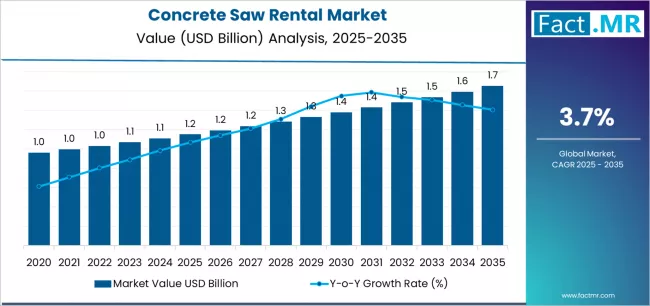
Quick Stats for Concrete Saw Rental Market
| Concrete Saw Rental Market Value (2025) | USD 1,150.0 million |
|---|---|
| Concrete Saw Rental Market Forecast Value (2035) | USD 1,650.0 million |
| Concrete Saw Rental Market CAGR | 3.7% |
| Leading Segment by Type (2025) | Handheld (45.0%) |
| Leading Segment by Application (2025) | Cutting (55.0%) |
| Leading Segment by Power (2025) | Gas (50.0%) |
| Key Growth Regions | Asia Pacific, North America, and Europe |
| Top Companies by Market Share | Husqvarna, United Rentals, Sunbelt, HSS |
Concrete cutting equipment rental represents a specialized niche where precision meets brutality. Diamond-embedded blades slice through reinforced concrete at 10,000 RPM while contractors calculate costs per linear foot. Handheld models dominate because mobility often outweighs raw cutting power - a 20-pound saw maneuvering through tight spaces proves more valuable than a 200-pound walk-behind unit requiring crane placement.
Gas engines power half the market despite noise complaints and emission concerns. Construction sites lack reliable electrical infrastructure, making cord-free operation essential for productivity. A typical gas-powered handheld saw burns one liter of fuel hourly while delivering 5 horsepower through a 14-inch diamond blade. Electric alternatives offer quieter operation crucial for hospital renovations and residential projects where noise ordinances restrict operating hours.
Rental economics favor short-term access over equipment ownership for most contractors. Diamond blades cost $200-500 each and wear rapidly when cutting through rebar-reinforced concrete. Rental companies absorb blade replacement costs while contractors pay daily rates averaging $150 for handheld units. This arrangement shifts the burden of blade selection expertise and inventory management to rental specialists who understand which diamond bond formulations work best for specific concrete compositions.
Cutting applications extend beyond simple demolition work. Road construction crews use saws for expansion joint creation and pavement repair sections. Utility installation requires precise openings through existing concrete structures without damaging surrounding areas. Emergency response teams need rapid access through concrete barriers during disaster recovery operations. Each application demands different blade configurations and cutting techniques.
Dust control requirements reshape equipment design and rental terms. OSHA silica exposure regulations mandate engineering controls including vacuum dust collection systems or wet cutting methods. Rental companies invest in integrated dust collection equipment to ensure customer compliance. Water cooling systems extend blade life while eliminating airborne particles, but complicate indoor cutting where drainage becomes problematic.
Technology integration proceeds slowly in this conservative market. GPS tracking prevents equipment theft - concrete saws disappear frequently from construction sites. Hour meters enable predictive maintenance scheduling based on actual usage rather than calendar intervals. Vibration dampening systems reduce operator fatigue during extended cutting sessions, addressing white finger syndrome liability concerns.
Concrete Saw Rental Market Key Takeaways
| Metric | Value |
|---|---|
| Market Value (2025) | USD 1,150.0 million |
| Market Forecast Value (2035) | USD 1,650.0 million |
| Forecast CAGR (2025-2035) | 3.7% |
Why is the Concrete Saw Rental Market Growing?
| CONSTRUCTION & INFRASTRUCTURE TRENDS | EQUIPMENT EFFICIENCY REQUIREMENTS | REGULATORY & SAFETY STANDARDS |
|---|---|---|
| Global Construction Growth Continued expansion of construction activities across established and emerging markets driving demand for professional cutting equipment solutions. Urban Development Projects Growing emphasis on urban infrastructure and commercial development creating demand for specialized concrete cutting equipment. Infrastructure Modernization Superior cutting properties and operational reliability characteristics making concrete saw rentals essential for professional construction applications. | Advanced Performance Requirements Modern construction projects require high-performance concrete cutting tools delivering precise cutting control and operational efficiency. Processing Efficiency Demands Rental companies investing in advanced concrete cutting equipment offering consistent performance while maintaining operational efficiency. Quality and Reliability Standards Certified rental providers with proven track records required for advanced concrete cutting applications. | Occupational Safety Standards Regulatory requirements establishing safety benchmarks favoring professional-grade cutting equipment. Equipment Performance Standards Quality standards requiring superior cutting capabilities and resistance to operational stresses in construction environments. Industry Compliance Requirements Diverse construction requirements and safety standards driving need for professional cutting equipment inputs. |
Concrete Saw Rental Market Segmentation
| Category | Segments Covered |
|---|---|
| By Type | Handheld, Walk-behind, Wall/Wire |
| By Application | Cutting, Demolition, Roadworks |
| By Power | Gas, Electric, Hydraulic |
| By Region | North America, Europe, Asia Pacific, Latin America, Middle East & Africa |
Concrete Saw Rental Market Analysis by Type
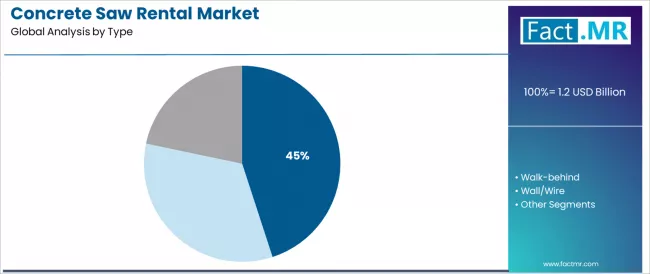
| Segment | 2025 to 2035 Outlook |
|---|---|
| Handheld | Leader in 2025 with 45.0% market share; likely to maintain leadership through 2035. Broadest use across cutting, demolition, and roadworks applications, mature supply chain, predictable functionality. Momentum: steady-to-strong. Watchouts: power source availability. |
| Walk-behind | Cost-effective and well-established for construction applications, but operational complexity limits broader adoption in specialized cutting applications. Momentum: steady in traditional construction; flat to slightly up in premium segments. |
| Wall/Wire | Benefiting from advanced cutting requirements due to specialized precision properties and enhanced performance characteristics. Momentum: rising. Watchouts: technical qualification requirements. |
Concrete Saw Rental Market Analysis by Application
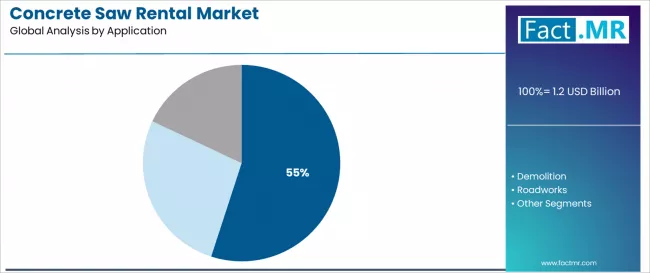
| Segment | 2025 to 2035 Outlook |
|---|---|
| Cutting | At 55.0%, largest application segment in 2025 with established concrete cutting integration. Mature supply chains standardize operational specifications. Momentum: steady growth driven by construction activity and infrastructure demand. Watchouts: regulatory changes affecting cutting requirements. |
| Demolition | Strong growth segment driven by urban renovation and infrastructure projects. Handheld and walk-behind equipment dominate applications. Momentum: strong growth through 2030, supported by urban redevelopment activities. Watchouts: competition from alternative demolition technologies. |
| Roadworks | Specialized segment with diverse cutting requirements. Growing demand for road construction supporting higher-value infrastructure applications. Momentum: moderate growth via infrastructure expansion and road development. Watchouts: regulatory requirements affecting road construction. |
Concrete Saw Rental Market Analysis by Power
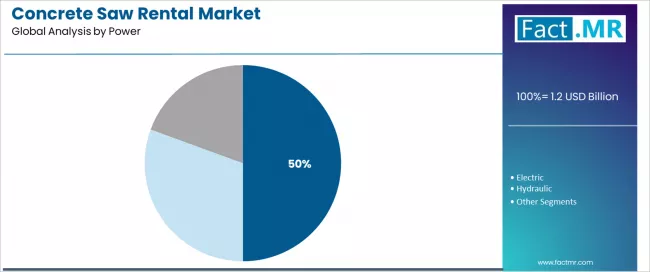
| Power | Status & Outlook 2025-2035 |
|---|---|
| Gas | Dominant power source in 2025 with 50.0% share for construction applications. Mobility advantages, operational independence, ease of deployment. Momentum: steady growth driven by operational efficiency and mobility advantages. Watchouts: environmental regulations in urban areas. |
| Electric | Important for indoor and specialized applications requiring precise control. Value-add through reduced emissions, operational efficiency, noise control. Momentum: moderate growth as environmental regulations demand cleaner operations. Processing complexity may limit broader growth. |
| Hydraulic | Specialized power source for heavy-duty applications requiring maximum cutting power. Limited market share but essential for specific construction requirements. Momentum: selective growth in heavy construction applications. |
DRIVERS
| DRIVERS | RESTRAINTS | KEY TRENDS |
|---|---|---|
| Global Construction Growth Continuing expansion of construction activities across established and emerging markets driving demand for professional concrete cutting solutions. Infrastructure Development Projects Increasing adoption of advanced cutting systems importance in construction efficiency and project completion optimization. Professional Rental Demand Growing demand for cutting equipment that supports both performance benefits and operational efficiency in construction projects. | Equipment Cost Volatility Price fluctuations affecting rental costs and supply chain predictability for rental companies. Operational Complexity Complex technical requirements across applications affecting equipment deployment and standardization. Technical Qualification Requirements Complex technical requirements across applications affecting equipment development and standardization. Competition from Alternatives Alternative cutting technologies affecting market selection and development. | Advanced Equipment Technologies Integration of advanced concrete cutting systems, operational innovations, and performance control solutions enabling superior efficiency. Performance Enhancement Enhanced cutting control, improved operational reliability, and advanced performance capabilities compared to traditional cutting systems. Specialized Equipment Development of specialized concrete cutting grades and custom equipment providing enhanced performance benefits and application-specific optimization. Technical Innovation Integration of advanced concrete cutting development and intelligent operational management for professional construction solutions. |
Analysis of Concrete Saw Rental Market by Key Countries
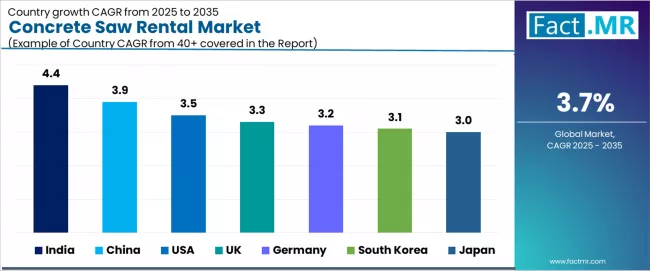
| Country | CAGR (2025-2035) |
|---|---|
| India | 4.4% |
| China | 3.9% |
| USA | 3.5% |
| UK | 3.3% |
| Germany | 3.2% |
| South Korea | 3.1% |
| Japan | 3.0% |
India Leads Global Market Growth with Construction Excellence
Revenue from concrete saw rentals in India is projected to exhibit strong growth driven by expanding construction infrastructure and comprehensive infrastructure development creating opportunities for equipment rental providers across residential construction operations, commercial building applications, and infrastructure construction sectors. The country's developing construction tradition and expanding infrastructure capabilities are creating demand for both conventional and high-performance concrete cutting equipment. Major construction companies are establishing comprehensive local equipment rental facilities to support large-scale construction operations and meet growing demand for efficient cutting solutions.
Health and safety industry modernization programs are supporting widespread adoption of advanced concrete cutting equipment across construction operations, driving demand for high-quality cutting equipment. Construction processing excellence initiatives and specialized infrastructure development are creating opportunities for equipment suppliers requiring reliable cutting performance and cost-effective concrete cutting solutions. Infrastructure construction growth and construction processing development are facilitating adoption of professional cutting equipment throughout major construction regions.
China Demonstrates Strong Market Potential with Construction Processing Growth
Revenue from concrete saw rentals in China is expanding supported by extensive construction expansion and comprehensive infrastructure industry development creating demand for reliable cutting equipment across diverse construction categories and specialized infrastructure segments. The country's dominant construction production position and expanding infrastructure capabilities are driving demand for concrete cutting solutions that provide consistent performance while supporting cost-effective processing requirements. Construction processors and contractors are investing in rental facilities to support growing construction operations and infrastructure demand.
Construction operations expansion and infrastructure processing capability development are creating opportunities for cutting equipment across diverse construction segments requiring reliable performance and competitive operational costs. Construction modernization and processing technology advancement are driving investments in equipment supply chains supporting performance requirements throughout major construction regions. Infrastructure construction growth and specialized development programs are enhancing demand for construction-grade cutting equipment throughout infrastructure production areas.
USA Maintains Strong Position with Premium Construction Innovation
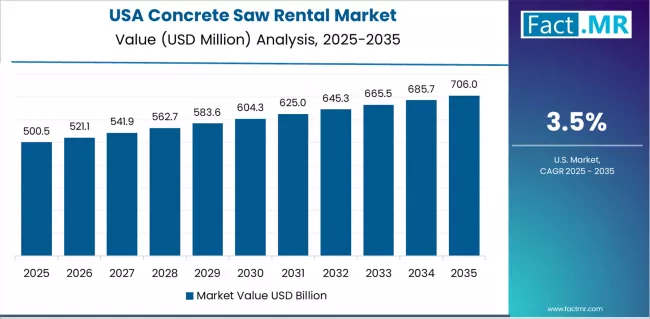
Demand for concrete saw rentals in USA is projected to grow supported by the country's expanding construction base and infrastructure processing technologies requiring advanced cutting equipment systems for construction production and infrastructure applications. American construction companies are implementing equipment systems that support advanced construction techniques, operational efficiency, and comprehensive safety protocols. The market is characterized by focus on operational excellence, construction performance, and compliance with construction safety standards.
Premium construction industry investments are prioritizing advanced processing technologies that demonstrate superior cutting performance and quality while meeting American construction standards. Infrastructure processing leadership programs and operational excellence initiatives are driving adoption of precision-engineered cutting equipment that supports advanced construction systems and performance optimization. Research and development programs for cutting enhancement are facilitating adoption of specialized processing techniques throughout major construction centers.
UK Expands Market with Construction Innovation
Revenue from concrete saw rentals in UK is growing driven by advanced construction development programs and increasing infrastructure technology innovation creating opportunities for cutting equipment suppliers serving both construction operations and infrastructure contractors. The country's extensive construction base and expanding infrastructure awareness are creating demand for cutting equipment that supports diverse performance requirements while maintaining processing performance standards. Construction contractors and equipment service providers are developing procurement strategies to support operational efficiency and regulatory compliance.
Advanced infrastructure development programs and cutting equipment processing are facilitating adoption of concrete cutting equipment capable of supporting diverse cutting requirements and competitive processing standards. Infrastructure equipment innovation and performance-focused development programs are enhancing demand for construction-grade cutting equipment that supports operational efficiency and performance reliability. Premium construction market expansion and specialized infrastructure development are creating opportunities for advanced cutting equipment processing capabilities across UK construction facilities.
Germany Focuses on Premium Construction Processing
Demand for concrete saw rentals in Germany is projected to grow driven by premium construction excellence and specialty cutting equipment capabilities supporting advanced infrastructure development and comprehensive construction applications. The country's established construction processing tradition and growing performance construction market segments are creating demand for high-quality cutting equipment that supports operational performance and construction standards. Construction contractors and processing suppliers are maintaining comprehensive development capabilities to support diverse construction requirements.
Premium construction processing and specialty cutting equipment programs are supporting demand for construction-grade concrete cutting equipment that meet contemporary performance and reliability standards. Infrastructure development and performance-focused construction programs are creating opportunities for specialized cutting equipment that provides comprehensive construction support. Construction modernization and infrastructure quality enhancement programs are facilitating adoption of advanced processing capabilities throughout major construction regions.
South Korea Focuses on Advanced Construction Processing
Demand for concrete saw rentals in South Korea is projected to grow at 3.1% CAGR driven by advanced construction excellence and specialty cutting equipment capabilities supporting infrastructure development and comprehensive construction applications. The country's established construction processing tradition and growing performance construction market segments are creating demand for high-quality cutting equipment that supports operational performance and construction standards.
Advanced construction processing and specialty cutting equipment programs are supporting demand for construction-grade concrete cutting equipment that meet contemporary performance and reliability standards. Infrastructure development and performance-focused construction programs are creating opportunities for specialized cutting equipment that provides comprehensive construction support. Construction modernization and infrastructure quality enhancement programs are facilitating adoption of advanced processing capabilities throughout major construction regions.
Japan Focuses on Precision Construction Processing
Demand for concrete saw rentals in Japan is projected to grow driven by precision construction excellence and specialty cutting equipment capabilities supporting advanced infrastructure development and comprehensive technical applications. The country's established construction processing tradition and growing performance construction market segments are creating demand for high-quality cutting equipment that supports operational performance and construction standards.
Precision construction processing and specialty cutting equipment programs are supporting demand for construction-grade concrete cutting equipment that meet contemporary performance and reliability standards. Infrastructure development and performance-focused construction programs are creating opportunities for specialized cutting equipment that provides comprehensive construction support. Construction modernization and infrastructure quality enhancement programs are facilitating adoption of advanced processing capabilities throughout major construction regions.
Europe Market Split by Processing Application
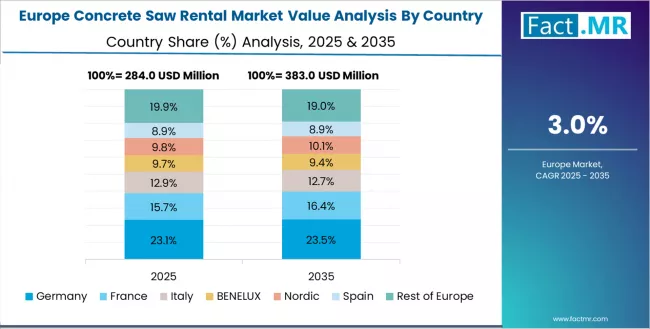
European concrete saw rental operations are increasingly polarized between Western European precision processing and Eastern European cost-competitive operations. German (USD 240.0 million) and UK facilities (USD 180.0 million) dominate premium construction and infrastructure cutting equipment processing, leveraging advanced construction technologies and strict quality protocols that command price premiums in global markets. German processors maintain leadership in high-performance cutting equipment applications, with major construction companies driving technical specifications that smaller suppliers must meet to access supply contracts.
France (USD 150.0 million), Italy (USD 120.0 million), and Spain (USD 100.0 million) operations focus on specialized applications and regional market requirements. Rest of Europe (USD 360.0 million) including Eastern European operations in Poland, Hungary, and Czech Republic are capturing volume-oriented processing contracts through labor cost advantages and EU regulatory compliance, particularly in standard cutting equipment for construction applications.
The regulatory environment presents both opportunities and constraints. EU construction regulations and safety directives create barriers for novel cutting equipment but establish quality standards that favor established European processors over imports. Brexit has fragmented UK sourcing from EU suppliers, creating opportunities for direct relationships between processors and British construction companies.
Supply chain consolidation accelerates as processors seek economies of scale to absorb rising energy costs and compliance expenses. Vertical integration increases, with major construction companies acquiring processing facilities to secure cutting equipment supplies and quality control. Smaller processors face pressure to specialize in niche applications or risk displacement by larger, more efficient operations serving mainstream construction requirements.
Premium Quality Standards Define Japanese Market Dynamics
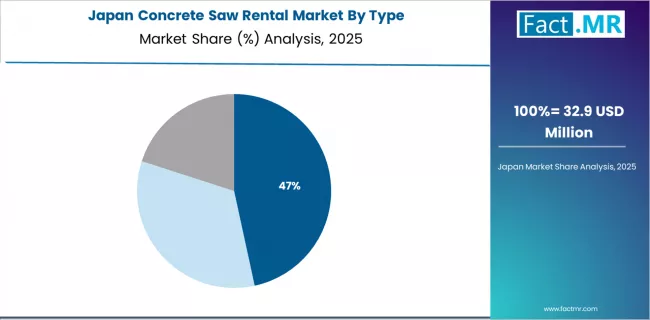
Japanese concrete saw rental operations reflect the country's exacting quality standards and construction expectations. Major construction companies maintain rigorous supplier qualification processes that often exceed international standards, requiring extensive documentation, batch testing, and facility audits that can take 12-18 months to complete. This creates high barriers for new suppliers but ensures consistent quality that supports premium construction positioning.
The Japanese market demonstrates unique application preferences with Cutting accounting for 55.0%, Demolition 30.0%, and Roadworks 15.0%. Companies require specific cutting ratios and performance specifications that differ from Western applications, driving demand for customized processing capabilities.
Japanese market demonstrates unique type preferences with Handheld accounting for 50.0%, Walk-behind 35.0%, and Wall/Wire 15.0%. Companies require specific cutting binding and performance specifications that differ from Western applications, driving demand for customized equipment capabilities.
Regulatory oversight emphasizes comprehensive construction equipment management and traceability requirements that surpass most international standards. The equipment registration system requires detailed sourcing information, creating advantages for suppliers with transparent supply chains and comprehensive documentation systems.
Supply chain management focuses on relationship-based partnerships rather than purely transactional procurement. Japanese companies typically maintain long-term supplier relationships spanning decades, with annual contract negotiations emphasizing quality consistency over price competition. This stability supports investment in specialized processing equipment tailored to Japanese specifications.
Market Dynamics Drive Innovation in South Korea
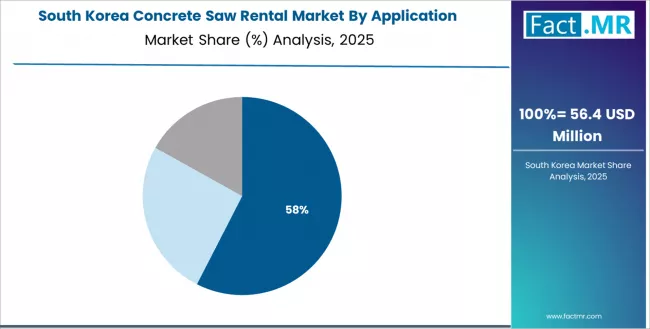
South Korean concrete saw rental operations reflect the country's advanced construction sector and export-oriented business model. Major construction companies drive advanced equipment procurement strategies, establishing direct relationships with global suppliers to secure consistent quality and pricing for their construction and infrastructure operations targeting both domestic and international markets.
The Korean market demonstrates particular strength in application distribution with Cutting accounting for 60.0%, Demolition 25.0%, and Roadworks 15.0%. This construction-focused approach creates demand for specific performance specifications that differ from Western applications, requiring suppliers to adapt equipment and operational techniques.
Regulatory frameworks emphasize construction equipment safety and traceability, with Korean construction administration standards often exceeding international requirements. This creates barriers for smaller construction suppliers but benefits established processors who can demonstrate compliance capabilities. The regulatory environment particularly favors suppliers with comprehensive certification and documentation systems.
Supply chain efficiency remains critical given Korea's geographic limitations and import dependence. Companies increasingly pursue long-term contracts with suppliers in United States, Germany, and Japan to ensure reliable access to raw materials while managing foreign exchange risks. Technical logistics investments support quality preservation during extended shipping periods.
The market faces pressure from rising labor costs and competition from lower-cost regional manufacturers, driving automation investments and consolidation among smaller processors. The premium positioning of Korean construction brands internationally continues to support demand for high-quality cutting equipment that meets stringent specifications.
Competitive Landscape of Concrete Saw Rental Market
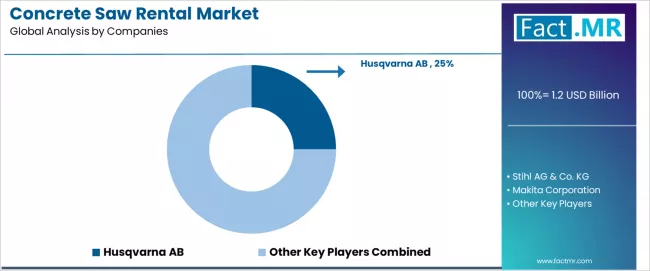
Profit pools are consolidating upstream in scaled concrete cutting equipment systems and downstream in value-added specialty equipment for construction, demolition, and roadworks applications where certification, traceability, and consistent performance command premiums. Value is migrating from basic equipment commodity trading to specification-tight, application-ready concrete cutting equipment where technical expertise and quality control drive competitive advantage.
Several archetypes set the pace: global equipment integrators defending share through production scale and technical reliability; multi-grade processors that manage complexity and serve diverse applications; specialty cutting equipment developers with construction expertise and industry ties; and performance-driven suppliers pulling volume in premium construction and infrastructure applications.
Switching costs include re-qualification, performance testing, operational validation provide stability for incumbents, while supply shocks and regulatory changes reopen opportunities for diversified suppliers. Consolidation and verticalization continue; digital procurement emerge in commodity grades while premium specifications remain relationship led.
| Stakeholder Type | Primary Advantage | Repeatable Plays |
|---|---|---|
| Global equipment integrators | Scale, production integration, technical reliability | Long-term contracts, tight specs, co-development with construction/infrastructure |
| Multi-grade processors | Grade diversification, application expertise, supply flexibility | Multi-application serving, technical support, quality assurance across segments |
| Specialty cutting equipment developers | Construction expertise and industry relationships | Custom equipment, performance claims, construction SLAs |
| Performance suppliers | Application-focused demand and specialized service | Technical performance claims, specialized grades, application activation |
| Equipment distributors & platforms | Technical support for mid-tier contractors | Equipment selection, smaller volumes, technical service |
Key Players in the Concrete Saw Rental Market
- Husqvarna AB
- Stihl AG & Co. KG
- Makita Corporation
- Hilti AG
- DeWalt (Stanley Black & Decker, Inc. brand)
- Norton Clipper (Saint-Gobain Abrasives brand)
- Tyrolit Schleifmittelwerke Swarovski KG
- ICS (Industrial Cutting Systems)
- CS Unitec, Inc.
- EDCO, Inc.
- Sunbelt Rentals (Ashtead Group plc brand)
- United Rentals, Inc.
- Boels Rental B.V.
- HSS Hire Group plc
- Ashtead Group plc
Scope of the Report
| Items | Values |
|---|---|
| Quantitative Units (2025) | USD 1,150.0 Million |
| Type | Handheld, Walk-behind, Wall/Wire |
| Application | Cutting, Demolition, Roadworks |
| Power | Gas, Electric, Hydraulic |
| Regions Covered | North America, Europe, Asia Pacific, Latin America, Middle East & Africa |
| Countries Covered | United States, Germany, China, Japan, India, South Korea, UK, and other 40+ countries |
| Key Companies Profiled | Husqvarna, Stihl, Makita, Hilti, DeWalt, Norton Clipper, Tyrolit, ICS, CS Unitec, EDCO, Sunbelt, United Rentals, Boels, HSS, Ashtead |
| Additional Attributes | Dollar sales by product/application/power, regional demand (NA, EU, APAC), competitive landscape, gas vs. electric adoption, production/processing integration, and advanced processing innovations driving performance enhancement, technical advancement, and efficiency |
Concrete Saw Rental Market Segmentation
-
By Type :
- Handheld
- Walk-behind
- Wall/Wire
-
By Application :
- Cutting
- Demolition
- Roadworks
-
By Power :
- Gas
- Electric
- Hydraulic
-
By Region :
- North America
- Europe
- Asia Pacific
- Latin America
- Middle East & Africa
Table of Content
- Executive Summary
- Global Market Outlook
- Demand to side Trends
- Supply to side Trends
- Technology Roadmap Analysis
- Analysis and Recommendations
- Market Overview
- Market Coverage / Taxonomy
- Market Definition / Scope / Limitations
- Market Background
- Market Dynamics
- Drivers
- Restraints
- Opportunity
- Trends
- Scenario Forecast
- Demand in Optimistic Scenario
- Demand in Likely Scenario
- Demand in Conservative Scenario
- Opportunity Map Analysis
- Product Life Cycle Analysis
- Supply Chain Analysis
- Investment Feasibility Matrix
- Value Chain Analysis
- PESTLE and Porter’s Analysis
- Regulatory Landscape
- Regional Parent Market Outlook
- Production and Consumption Statistics
- Import and Export Statistics
- Market Dynamics
- Global Market Analysis 2020 to 2024 and Forecast, 2025 to 2035
- Historical Market Size Value (USD Million) Analysis, 2020 to 2024
- Current and Future Market Size Value (USD Million) Projections, 2025 to 2035
- Y to o to Y Growth Trend Analysis
- Absolute $ Opportunity Analysis
- Global Market Pricing Analysis 2020 to 2024 and Forecast 2025 to 2035
- Global Market Analysis 2020 to 2024 and Forecast 2025 to 2035, By Type
- Introduction / Key Findings
- Historical Market Size Value (USD Million) Analysis By Type , 2020 to 2024
- Current and Future Market Size Value (USD Million) Analysis and Forecast By Type , 2025 to 2035
- Handheld
- Walk-behind
- Wall/Wire
- Y to o to Y Growth Trend Analysis By Type , 2020 to 2024
- Absolute $ Opportunity Analysis By Type , 2025 to 2035
- Global Market Analysis 2020 to 2024 and Forecast 2025 to 2035, By Application
- Introduction / Key Findings
- Historical Market Size Value (USD Million) Analysis By Application, 2020 to 2024
- Current and Future Market Size Value (USD Million) Analysis and Forecast By Application, 2025 to 2035
- Cutting
- Demolition
- Roadworks
- Y to o to Y Growth Trend Analysis By Application, 2020 to 2024
- Absolute $ Opportunity Analysis By Application, 2025 to 2035
- Global Market Analysis 2020 to 2024 and Forecast 2025 to 2035, By Power
- Introduction / Key Findings
- Historical Market Size Value (USD Million) Analysis By Power, 2020 to 2024
- Current and Future Market Size Value (USD Million) Analysis and Forecast By Power, 2025 to 2035
- Gas
- Electric
- Hydraulic
- Y to o to Y Growth Trend Analysis By Power, 2020 to 2024
- Absolute $ Opportunity Analysis By Power, 2025 to 2035
- Global Market Analysis 2020 to 2024 and Forecast 2025 to 2035, By Region
- Introduction
- Historical Market Size Value (USD Million) Analysis By Region, 2020 to 2024
- Current Market Size Value (USD Million) Analysis and Forecast By Region, 2025 to 2035
- North America
- Latin America
- Western Europe
- Eastern Europe
- East Asia
- South Asia and Pacific
- Middle East & Africa
- Market Attractiveness Analysis By Region
- North America Market Analysis 2020 to 2024 and Forecast 2025 to 2035, By Country
- Historical Market Size Value (USD Million) Trend Analysis By Market Taxonomy, 2020 to 2024
- Market Size Value (USD Million) Forecast By Market Taxonomy, 2025 to 2035
- By Country
- USA
- Canada
- Mexico
- By Type
- By Application
- By Power
- By Country
- Market Attractiveness Analysis
- By Country
- By Type
- By Application
- By Power
- Key Takeaways
- Latin America Market Analysis 2020 to 2024 and Forecast 2025 to 2035, By Country
- Historical Market Size Value (USD Million) Trend Analysis By Market Taxonomy, 2020 to 2024
- Market Size Value (USD Million) Forecast By Market Taxonomy, 2025 to 2035
- By Country
- Brazil
- Chile
- Rest of Latin America
- By Type
- By Application
- By Power
- By Country
- Market Attractiveness Analysis
- By Country
- By Type
- By Application
- By Power
- Key Takeaways
- Western Europe Market Analysis 2020 to 2024 and Forecast 2025 to 2035, By Country
- Historical Market Size Value (USD Million) Trend Analysis By Market Taxonomy, 2020 to 2024
- Market Size Value (USD Million) Forecast By Market Taxonomy, 2025 to 2035
- By Country
- Germany
- UK
- Italy
- Spain
- France
- Nordic
- BENELUX
- Rest of Western Europe
- By Type
- By Application
- By Power
- By Country
- Market Attractiveness Analysis
- By Country
- By Type
- By Application
- By Power
- Key Takeaways
- Eastern Europe Market Analysis 2020 to 2024 and Forecast 2025 to 2035, By Country
- Historical Market Size Value (USD Million) Trend Analysis By Market Taxonomy, 2020 to 2024
- Market Size Value (USD Million) Forecast By Market Taxonomy, 2025 to 2035
- By Country
- Russia
- Poland
- Hungary
- Balkan & Baltic
- Rest of Eastern Europe
- By Type
- By Application
- By Power
- By Country
- Market Attractiveness Analysis
- By Country
- By Type
- By Application
- By Power
- Key Takeaways
- East Asia Market Analysis 2020 to 2024 and Forecast 2025 to 2035, By Country
- Historical Market Size Value (USD Million) Trend Analysis By Market Taxonomy, 2020 to 2024
- Market Size Value (USD Million) Forecast By Market Taxonomy, 2025 to 2035
- By Country
- China
- Japan
- South Korea
- By Type
- By Application
- By Power
- By Country
- Market Attractiveness Analysis
- By Country
- By Type
- By Application
- By Power
- Key Takeaways
- South Asia and Pacific Market Analysis 2020 to 2024 and Forecast 2025 to 2035, By Country
- Historical Market Size Value (USD Million) Trend Analysis By Market Taxonomy, 2020 to 2024
- Market Size Value (USD Million) Forecast By Market Taxonomy, 2025 to 2035
- By Country
- India
- ASEAN
- Australia & New Zealand
- Rest of South Asia and Pacific
- By Type
- By Application
- By Power
- By Country
- Market Attractiveness Analysis
- By Country
- By Type
- By Application
- By Power
- Key Takeaways
- Middle East & Africa Market Analysis 2020 to 2024 and Forecast 2025 to 2035, By Country
- Historical Market Size Value (USD Million) Trend Analysis By Market Taxonomy, 2020 to 2024
- Market Size Value (USD Million) Forecast By Market Taxonomy, 2025 to 2035
- By Country
- Kingdom of Saudi Arabia
- Other GCC Countries
- Turkiye
- South Africa
- Other African Union
- Rest of Middle East & Africa
- By Type
- By Application
- By Power
- By Country
- Market Attractiveness Analysis
- By Country
- By Type
- By Application
- By Power
- Key Takeaways
- Key Countries Market Analysis
- USA
- Pricing Analysis
- Market Share Analysis, 2024
- By Type
- By Application
- By Power
- Canada
- Pricing Analysis
- Market Share Analysis, 2024
- By Type
- By Application
- By Power
- Mexico
- Pricing Analysis
- Market Share Analysis, 2024
- By Type
- By Application
- By Power
- Brazil
- Pricing Analysis
- Market Share Analysis, 2024
- By Type
- By Application
- By Power
- Chile
- Pricing Analysis
- Market Share Analysis, 2024
- By Type
- By Application
- By Power
- Germany
- Pricing Analysis
- Market Share Analysis, 2024
- By Type
- By Application
- By Power
- UK
- Pricing Analysis
- Market Share Analysis, 2024
- By Type
- By Application
- By Power
- Italy
- Pricing Analysis
- Market Share Analysis, 2024
- By Type
- By Application
- By Power
- Spain
- Pricing Analysis
- Market Share Analysis, 2024
- By Type
- By Application
- By Power
- France
- Pricing Analysis
- Market Share Analysis, 2024
- By Type
- By Application
- By Power
- India
- Pricing Analysis
- Market Share Analysis, 2024
- By Type
- By Application
- By Power
- ASEAN
- Pricing Analysis
- Market Share Analysis, 2024
- By Type
- By Application
- By Power
- Australia & New Zealand
- Pricing Analysis
- Market Share Analysis, 2024
- By Type
- By Application
- By Power
- China
- Pricing Analysis
- Market Share Analysis, 2024
- By Type
- By Application
- By Power
- Japan
- Pricing Analysis
- Market Share Analysis, 2024
- By Type
- By Application
- By Power
- South Korea
- Pricing Analysis
- Market Share Analysis, 2024
- By Type
- By Application
- By Power
- Russia
- Pricing Analysis
- Market Share Analysis, 2024
- By Type
- By Application
- By Power
- Poland
- Pricing Analysis
- Market Share Analysis, 2024
- By Type
- By Application
- By Power
- Hungary
- Pricing Analysis
- Market Share Analysis, 2024
- By Type
- By Application
- By Power
- Kingdom of Saudi Arabia
- Pricing Analysis
- Market Share Analysis, 2024
- By Type
- By Application
- By Power
- Turkiye
- Pricing Analysis
- Market Share Analysis, 2024
- By Type
- By Application
- By Power
- South Africa
- Pricing Analysis
- Market Share Analysis, 2024
- By Type
- By Application
- By Power
- USA
- Market Structure Analysis
- Competition Dashboard
- Competition Benchmarking
- Market Share Analysis of Top Players
- By Regional
- By Type
- By Application
- By Power
- Competition Analysis
- Competition Deep Dive
- Husqvarna AB
- Overview
- Product Portfolio
- Profitability by Market Segments (Product/Age /Sales Channel/Region)
- Sales Footprint
- Strategy Overview
- Marketing Strategy
- Product Strategy
- Channel Strategy
- Stihl AG & Co. KG
- Makita Corporation
- Hilti AG
- DeWalt (Stanley Black & Decker, Inc. brand)
- Norton Clipper (Saint-Gobain Abrasives brand)
- Tyrolit Schleifmittelwerke Swarovski KG
- ICS (Industrial Cutting Systems)
- CS Value (USD Million)ec, Inc.
- EDCO, Inc.
- Sunbelt Rentals (Ashtead Group plc brand)
- Value (USD Million)ed Rentals, Inc.
- Boels Rental B.V.
- HSS Hire Group plc
- Ashtead Group plc
- Husqvarna AB
- Competition Deep Dive
- Assumptions & Acronyms Used
- Research Methodology
List Of Table
- Table 1: Global Market Value (USD Million) Forecast by Region, 2020 to 2035
- Table 2: Global Market Value (USD Million) Forecast by Type , 2020 to 2035
- Table 3: Global Market Value (USD Million) Forecast by Application, 2020 to 2035
- Table 4: Global Market Value (USD Million) Forecast by Power, 2020 to 2035
- Table 5: North America Market Value (USD Million) Forecast by Country, 2020 to 2035
- Table 6: North America Market Value (USD Million) Forecast by Type , 2020 to 2035
- Table 7: North America Market Value (USD Million) Forecast by Application, 2020 to 2035
- Table 8: North America Market Value (USD Million) Forecast by Power, 2020 to 2035
- Table 9: Latin America Market Value (USD Million) Forecast by Country, 2020 to 2035
- Table 10: Latin America Market Value (USD Million) Forecast by Type , 2020 to 2035
- Table 11: Latin America Market Value (USD Million) Forecast by Application, 2020 to 2035
- Table 12: Latin America Market Value (USD Million) Forecast by Power, 2020 to 2035
- Table 13: Western Europe Market Value (USD Million) Forecast by Country, 2020 to 2035
- Table 14: Western Europe Market Value (USD Million) Forecast by Type , 2020 to 2035
- Table 15: Western Europe Market Value (USD Million) Forecast by Application, 2020 to 2035
- Table 16: Western Europe Market Value (USD Million) Forecast by Power, 2020 to 2035
- Table 17: Eastern Europe Market Value (USD Million) Forecast by Country, 2020 to 2035
- Table 18: Eastern Europe Market Value (USD Million) Forecast by Type , 2020 to 2035
- Table 19: Eastern Europe Market Value (USD Million) Forecast by Application, 2020 to 2035
- Table 20: Eastern Europe Market Value (USD Million) Forecast by Power, 2020 to 2035
- Table 21: East Asia Market Value (USD Million) Forecast by Country, 2020 to 2035
- Table 22: East Asia Market Value (USD Million) Forecast by Type , 2020 to 2035
- Table 23: East Asia Market Value (USD Million) Forecast by Application, 2020 to 2035
- Table 24: East Asia Market Value (USD Million) Forecast by Power, 2020 to 2035
- Table 25: South Asia and Pacific Market Value (USD Million) Forecast by Country, 2020 to 2035
- Table 26: South Asia and Pacific Market Value (USD Million) Forecast by Type , 2020 to 2035
- Table 27: South Asia and Pacific Market Value (USD Million) Forecast by Application, 2020 to 2035
- Table 28: South Asia and Pacific Market Value (USD Million) Forecast by Power, 2020 to 2035
- Table 29: Middle East & Africa Market Value (USD Million) Forecast by Country, 2020 to 2035
- Table 30: Middle East & Africa Market Value (USD Million) Forecast by Type , 2020 to 2035
- Table 31: Middle East & Africa Market Value (USD Million) Forecast by Application, 2020 to 2035
- Table 32: Middle East & Africa Market Value (USD Million) Forecast by Power, 2020 to 2035
List Of Figures
- Figure 1: Global Market Pricing Analysis
- Figure 2: Global Market Value (USD Million) Forecast 2020-2035
- Figure 3: Global Market Value Share and BPS Analysis by Type , 2025 and 2035
- Figure 4: Global Market Y to o to Y Growth Comparison by Type , 2025-2035
- Figure 5: Global Market Attractiveness Analysis by Type
- Figure 6: Global Market Value Share and BPS Analysis by Application, 2025 and 2035
- Figure 7: Global Market Y to o to Y Growth Comparison by Application, 2025-2035
- Figure 8: Global Market Attractiveness Analysis by Application
- Figure 9: Global Market Value Share and BPS Analysis by Power, 2025 and 2035
- Figure 10: Global Market Y to o to Y Growth Comparison by Power, 2025-2035
- Figure 11: Global Market Attractiveness Analysis by Power
- Figure 12: Global Market Value (USD Million) Share and BPS Analysis by Region, 2025 and 2035
- Figure 13: Global Market Y to o to Y Growth Comparison by Region, 2025-2035
- Figure 14: Global Market Attractiveness Analysis by Region
- Figure 15: North America Market Incremental Dollar Opportunity, 2025-2035
- Figure 16: Latin America Market Incremental Dollar Opportunity, 2025-2035
- Figure 17: Western Europe Market Incremental Dollar Opportunity, 2025-2035
- Figure 18: Eastern Europe Market Incremental Dollar Opportunity, 2025-2035
- Figure 19: East Asia Market Incremental Dollar Opportunity, 2025-2035
- Figure 20: South Asia and Pacific Market Incremental Dollar Opportunity, 2025-2035
- Figure 21: Middle East & Africa Market Incremental Dollar Opportunity, 2025-2035
- Figure 22: North America Market Value Share and BPS Analysis by Country, 2025 and 2035
- Figure 23: North America Market Value Share and BPS Analysis by Type , 2025 and 2035
- Figure 24: North America Market Y to o to Y Growth Comparison by Type , 2025-2035
- Figure 25: North America Market Attractiveness Analysis by Type
- Figure 26: North America Market Value Share and BPS Analysis by Application, 2025 and 2035
- Figure 27: North America Market Y to o to Y Growth Comparison by Application, 2025-2035
- Figure 28: North America Market Attractiveness Analysis by Application
- Figure 29: North America Market Value Share and BPS Analysis by Power, 2025 and 2035
- Figure 30: North America Market Y to o to Y Growth Comparison by Power, 2025-2035
- Figure 31: North America Market Attractiveness Analysis by Power
- Figure 32: Latin America Market Value Share and BPS Analysis by Country, 2025 and 2035
- Figure 33: Latin America Market Value Share and BPS Analysis by Type , 2025 and 2035
- Figure 34: Latin America Market Y to o to Y Growth Comparison by Type , 2025-2035
- Figure 35: Latin America Market Attractiveness Analysis by Type
- Figure 36: Latin America Market Value Share and BPS Analysis by Application, 2025 and 2035
- Figure 37: Latin America Market Y to o to Y Growth Comparison by Application, 2025-2035
- Figure 38: Latin America Market Attractiveness Analysis by Application
- Figure 39: Latin America Market Value Share and BPS Analysis by Power, 2025 and 2035
- Figure 40: Latin America Market Y to o to Y Growth Comparison by Power, 2025-2035
- Figure 41: Latin America Market Attractiveness Analysis by Power
- Figure 42: Western Europe Market Value Share and BPS Analysis by Country, 2025 and 2035
- Figure 43: Western Europe Market Value Share and BPS Analysis by Type , 2025 and 2035
- Figure 44: Western Europe Market Y to o to Y Growth Comparison by Type , 2025-2035
- Figure 45: Western Europe Market Attractiveness Analysis by Type
- Figure 46: Western Europe Market Value Share and BPS Analysis by Application, 2025 and 2035
- Figure 47: Western Europe Market Y to o to Y Growth Comparison by Application, 2025-2035
- Figure 48: Western Europe Market Attractiveness Analysis by Application
- Figure 49: Western Europe Market Value Share and BPS Analysis by Power, 2025 and 2035
- Figure 50: Western Europe Market Y to o to Y Growth Comparison by Power, 2025-2035
- Figure 51: Western Europe Market Attractiveness Analysis by Power
- Figure 52: Eastern Europe Market Value Share and BPS Analysis by Country, 2025 and 2035
- Figure 53: Eastern Europe Market Value Share and BPS Analysis by Type , 2025 and 2035
- Figure 54: Eastern Europe Market Y to o to Y Growth Comparison by Type , 2025-2035
- Figure 55: Eastern Europe Market Attractiveness Analysis by Type
- Figure 56: Eastern Europe Market Value Share and BPS Analysis by Application, 2025 and 2035
- Figure 57: Eastern Europe Market Y to o to Y Growth Comparison by Application, 2025-2035
- Figure 58: Eastern Europe Market Attractiveness Analysis by Application
- Figure 59: Eastern Europe Market Value Share and BPS Analysis by Power, 2025 and 2035
- Figure 60: Eastern Europe Market Y to o to Y Growth Comparison by Power, 2025-2035
- Figure 61: Eastern Europe Market Attractiveness Analysis by Power
- Figure 62: East Asia Market Value Share and BPS Analysis by Country, 2025 and 2035
- Figure 63: East Asia Market Value Share and BPS Analysis by Type , 2025 and 2035
- Figure 64: East Asia Market Y to o to Y Growth Comparison by Type , 2025-2035
- Figure 65: East Asia Market Attractiveness Analysis by Type
- Figure 66: East Asia Market Value Share and BPS Analysis by Application, 2025 and 2035
- Figure 67: East Asia Market Y to o to Y Growth Comparison by Application, 2025-2035
- Figure 68: East Asia Market Attractiveness Analysis by Application
- Figure 69: East Asia Market Value Share and BPS Analysis by Power, 2025 and 2035
- Figure 70: East Asia Market Y to o to Y Growth Comparison by Power, 2025-2035
- Figure 71: East Asia Market Attractiveness Analysis by Power
- Figure 72: South Asia and Pacific Market Value Share and BPS Analysis by Country, 2025 and 2035
- Figure 73: South Asia and Pacific Market Value Share and BPS Analysis by Type , 2025 and 2035
- Figure 74: South Asia and Pacific Market Y to o to Y Growth Comparison by Type , 2025-2035
- Figure 75: South Asia and Pacific Market Attractiveness Analysis by Type
- Figure 76: South Asia and Pacific Market Value Share and BPS Analysis by Application, 2025 and 2035
- Figure 77: South Asia and Pacific Market Y to o to Y Growth Comparison by Application, 2025-2035
- Figure 78: South Asia and Pacific Market Attractiveness Analysis by Application
- Figure 79: South Asia and Pacific Market Value Share and BPS Analysis by Power, 2025 and 2035
- Figure 80: South Asia and Pacific Market Y to o to Y Growth Comparison by Power, 2025-2035
- Figure 81: South Asia and Pacific Market Attractiveness Analysis by Power
- Figure 82: Middle East & Africa Market Value Share and BPS Analysis by Country, 2025 and 2035
- Figure 83: Middle East & Africa Market Value Share and BPS Analysis by Type , 2025 and 2035
- Figure 84: Middle East & Africa Market Y to o to Y Growth Comparison by Type , 2025-2035
- Figure 85: Middle East & Africa Market Attractiveness Analysis by Type
- Figure 86: Middle East & Africa Market Value Share and BPS Analysis by Application, 2025 and 2035
- Figure 87: Middle East & Africa Market Y to o to Y Growth Comparison by Application, 2025-2035
- Figure 88: Middle East & Africa Market Attractiveness Analysis by Application
- Figure 89: Middle East & Africa Market Value Share and BPS Analysis by Power, 2025 and 2035
- Figure 90: Middle East & Africa Market Y to o to Y Growth Comparison by Power, 2025-2035
- Figure 91: Middle East & Africa Market Attractiveness Analysis by Power
- Figure 92: Global Market - Tier Structure Analysis
- Figure 93: Global Market - Company Share Analysis
- FAQs -
How big is the concrete saw rental market in 2025?
The global concrete saw rental market is estimated to be valued at USD 1.2 billion in 2025.
What will be the size of concrete saw rental market in 2035?
The market size for the concrete saw rental market is projected to reach USD 1.7 billion by 2035.
How much will be the concrete saw rental market growth between 2025 and 2035?
The concrete saw rental market is expected to grow at a 3.7% CAGR between 2025 and 2035.
What are the key product types in the concrete saw rental market?
The key product types in concrete saw rental market are handheld, walk-behind and wall/wire.
Which application segment to contribute significant share in the concrete saw rental market in 2025?
In terms of application, cutting segment to command 55.0% share in the concrete saw rental market in 2025.